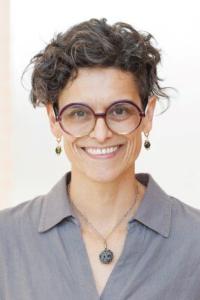
Environmental Health Scientist Strengthens Ties to Latin America
Marcela Tamayo-Ortiz first encountered the vibrant pottery created by the Purephecha potters of Michoacán as a child in the 1980s, when her family would travel from their home in bustling Mexico City to pastoral Pátzcuaro, Michoacán.
Tamayo-Ortiz would return to Pátzcuaro’s verdant hills in her early 20s, as an industrial designer trained at Mexico’s National Autonomous University and the École Nationale Supérieure de Création Industrielle, ENSCI Les Ateliers, in France. Only then—employed by a nonprofit that helped indigenous artisan collectives optimize their home-based pottery studios—would she learn about the toxic legacy of an innovation introduced by Spanish conquistadors in the 1500s: powdered lead monoxide, bought in convenience stores in town and mixed by hand by women, increases the lustre and durability of low-temperature ceramics, from wood-fired kilns. “It’s like the last transparent coat of gel on your nails,” says Tamayo-Ortiz, now a Columbia Mailman associate professor of Environmental Health Sciences, working at the Columbia Center for Children's Environmental Health.“It makes the piece brighter, shinier; it won’t break as easily. But it’s lead, diluted in water. The potters, their families, and communities are highly exposed, and as a population, when you eat out of those pots, you eat lead, because the lead leaches into the food.”
Her work with Purephecha potters launched Tamayo-Ortiz into the world of public health. Her master’s in environmental science at Mexico’s National Institute of Public Health investigated the health effects of lead in candy consumed by children in Mexico City. Her PhD research at Harvard’s Chan School of Public Health investigated how prenatal exposure to lead and stress affects infant neurodevelopment. She subsequently served as Head of the Occupational Health Research Department at the Mexican Social Security Institute, the largest health and social benefits provider in Latin America, using administrative data to track the COVID-19 pandemic. Since joining the Columbia Mailman faculty in 2023, she has continued her research on maternal-child environmental exposures, with a focus on women’s midlife bone health and healthy aging.
The project that introduced you to the hazards of lead took a harm reduction approach, introducing ways for artisans to reduce lead exposure in their households without eliminating lead-based glaze. Why?
Tamayo-Ortiz: Traditional potters use kilns that they build by themselves. They use wood from the forests and harvest clay from the mines. They use traditional, ancestral ways of production. Although they are aware that there’s no safe level of lead, the substitutes for lead-based glazes are still not reliable in all types of low-temperature production, nor are they as available or widely distributed. It’s very hard because we’re not attacking the artisans. This is part of our cultural heritage—but Mexican food is still frequently served in this type of pottery—and is a main source of exposure to lead to this day.
How did working with artisans, seeing their home-based production, inform your research?
Tamayo-Ortiz: I started working with the ELEMENT(Early Life Exposures in Mexico to Environmental Toxicants) and PROGRESS (Programming Research in Obesity, Growth, Environment and Social Stressors) birth cohort studies as a master’s student. Both studies had prenatal lead exposure and neurodevelopment as their original aims. There was a perfect link to what I had learned in the field about lead in an occupational setting to my epidemiological work. ELEMENT and PROGRESS have been instrumental to informing environmental policies in the U.S. and Mexico—including air quality regulations and eliminating the use of lead in gasoline in the 1990s. CCCEH has also produced pivotal science on air pollution, pesticides, and personal care products, shaping policy worldwide.
It sounds like those extended, ongoing relationships with participants also help you formulate new research questions.
Tamayo-Ortiz: Yes. Now I’m investigating more on the moms’ health, women’s health, how pregnancy can be an important, vulnerable time, and how it translates to women’s aging. With epidemiologists Sarah Tom and Rebecca Kehm I have launched the Mothers PATHWAY Initiative: Pregnancy to Aging Through Health and Wellbeing Assessment across the Years. We want to start focus groups and a mother’s experience council where women will be able to talk about midlife—the transition to menopause and everything that comes with that when you’re caring for both children and parents, and your susceptibility to environmental damage because your hormones, bones, and body are changing.
What is your vision as a member of the faculty leadership for the Columbia Global Center in Rio de Janeiro?
Tamayo-Ortiz: As the former chair of the Latin American and Caribbean Chapter of the International Society of Environmental Epidemiology, I’ve strengthened collaborations with other countries in Latin America, including Brazil. My goal with the Global Center is to bring environmental health science to our Rio Center. I’m looking to establish an international exchange and support more environmental health research.
How does your varied training and work experience affect your approach to teaching students in public health?
Tamayo-Ortiz: There’s a human connection that we’ll never be able to substitute with artificial intelligence. This experience—your life experience—it’s irreplaceable. You can learn all the theory, analyze data, but you’ll never be able to substitute what a human professor can teach you by talking and interacting. Something I like my students to reflect on is how much they already know. There are so many things that each person brings into a classroom, no matter how old you are. I’ve been lucky to teach smaller groups. We all come from different backgrounds and have different experiences. That’s very enriching. It opens your mind to other worlds because everyone has something to say, something to contribute, that will make your science better and make you a better person.
